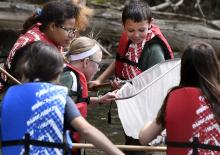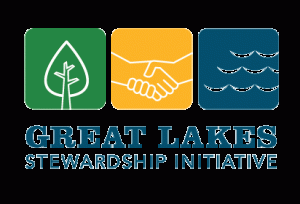Great Lakes Stewardship Initiative
Impact
Since 2007, more than 1,000 teachers and 98,000 students have participated in place-based stewardship education supported by the GLSI. In 2015-16, we offered 15,985 K-12 students from 108 schools the chance to engage in robust, inquiry-based projects that drew on the expertise and resources of community-based organizations. Many of these schools have worked with the GLSI for several years and are fielding increasingly sophisticated projects of great value to their communities. Documented positive impacts on students include: an improved ability to use STEM practices, enhanced civic capacity, gains in skills related to teamwork and collaboration, learning gains on environmental issues that are a focus of place-based stewardship education projects.
Accomplished
- Need Accomplished
- Evaluation Developing
- Sustainability Accomplished
- Replication & Scalability Accomplished
- Partnerships Accomplished
- Capacity Accomplished
- Challenging & Relevant Content Developing
- STEM Practices Accomplished
- Inspiration Accomplished
- Under-Represented Groups Developing

The Great Lakes Stewardship Initiative is one of the most comprehensive place-based education programs in the country. I’m completely impressed with how the program directors have devised strategies that simultaneously increase student engagement, improve academic achievement, and contribute to the improvement of environmental quality in the Great Lakes’ ecosystems. It’s like feeding a whole flock of birds with one hand.
Center for Place-based Education, Antioch New England Institute
Design Principles
The programs in this database clear a high bar. STEMworks reviewed each program against the Design Principles for Effective STEM Philanthropy. Programs must be Accomplished () across all Design Principles, or be Developing (
) in a maximum of three areas.
Overarching Principles
-
Need Accomplished
Identify and target a compelling and well-defined need.
-
Evaluation Developing
Use rigorous evaluation to continuously measure and inform progress towards the compelling need identified.
-
Sustainability Accomplished
Ensure work is sustainable.
-
Replication & Scalability Accomplished
Demonstrate replicability and scalability.
-
Partnerships Accomplished
Create high impact partnerships.
-
Capacity Accomplished
Ensure organizational capacity to achieve goals.
STEM Principles
-
Challenging & Relevant Content Developing
Offer challenging and relevant STEM content for the target audience.
-
STEM Practices Accomplished
Incorporate and encourage STEM practices.
-
Inspiration Accomplished
Inspire interest and engagement in STEM.
-
Under-Represented Groups Developing
Identify and address the needs of under-represented groups.
Program Overview
The Great Lakes Stewardship Initiative develops knowledgeable, active stewards of the Great Lakes by supporting hands-on environmental learning in communities. A network of nine sites across Michigan supports place-based education for K-12 students; offers professional development for K-12 teachers; and facilitates school-community partnerships. Students—with their teachers and local partners—plan and conduct projects about environmental issues in their communities. In the process, they learn academic content and gain skills in critical thinking, problem-solving, creativity, collaboration, and teamwork. The GLSI helps teachers incorporate STEM practices by a) offering a variety of professional development opportunities; b) providing coaching and guidance on the design of place-based stewardship education projects; c) convening meetings/conferences and creating publications that share best practices and exemplars; and d) facilitating school-community partnerships, which bring working scientists into K-12 education in direct support of students and teachers. Our Guiding Principles for Exemplary Place-based Stewardship Education and a related Self-assessment Rubric describe the nature and development of teaching and learning that we wish to see in K–12 schools and communities, and how it may develop. Case studies of exemplary place-based stewardship education show what the work looks like in real schools and communities across the urban-rural spectrum (see greatstewards.glstewardship.org).
Funders and Partners
Major Funders: Great Lakes Fishery Trust, Wege Foundation, U.S. Environmental Protection Agency, NOAA B-WET Program, Frey Foundation. Other Partners: Community Foundation for Northeast Michigan, Copper Country Intermediate School District, Eastern Michigan University, Grand Valley State University, Inland Seas Education Association, Michigan Department of Environmental Quality, Michigan Department of Natural Resources, Michigan Department of Education, Michigan State University, Michigan Technological University, Muskegon Area Intermediate School District, Superior Watershed Partnership, University of Michigan–Flint
